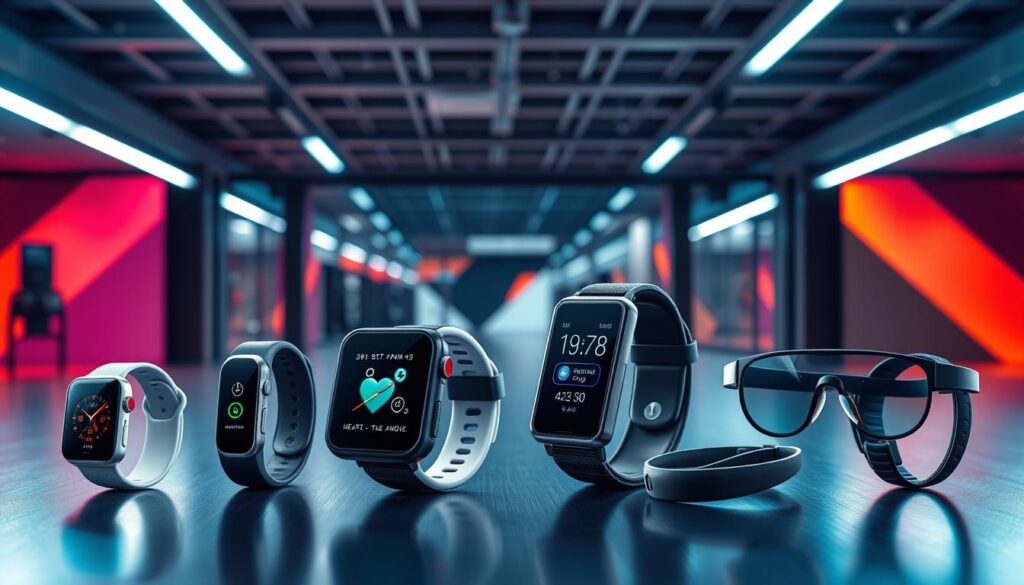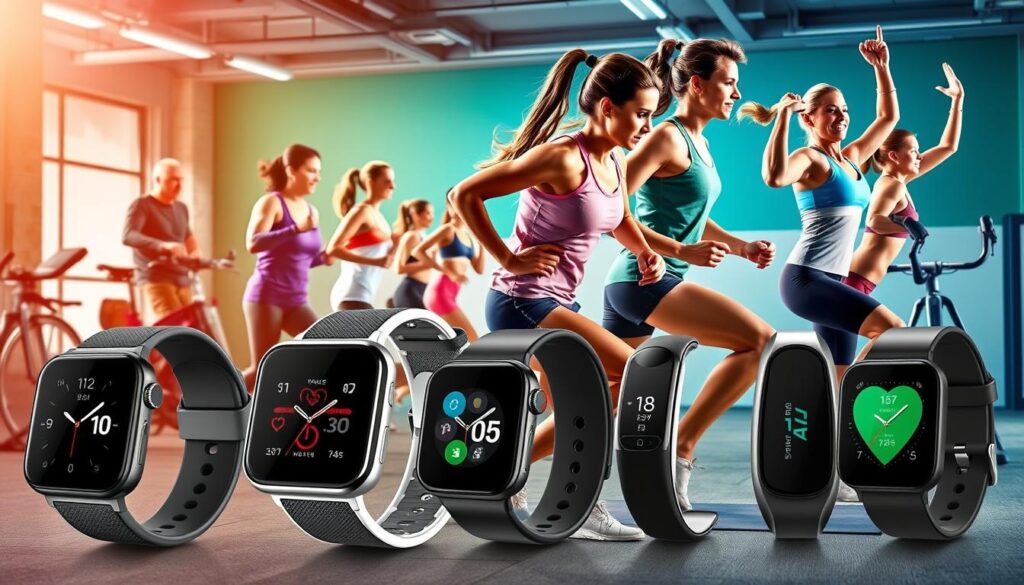Wearable technology for fitness is a big step forward in health tracking. It includes devices like smartwatches and fitness trackers. These gadgets help people track their fitness levels.
More and more people are using these devices to live healthier lives. They are not just useful; they also show how much people care about staying healthy. In fact, 82% of U.S. consumers say wellness is very important to them1.
This shift has changed how we track our health. It has become a key part of staying fit today.

Key Takeaways
- Wearable technology includes devices such as smartwatches and fitness trackers.
- These gadgets are designed to monitor health metrics for users seeking improved fitness.
- Interest in wellness and fitness tracking has significantly increased among consumers.
- 82% of U.S. consumers prioritize wellness, reflecting a growing trend in health monitoring.
- Wearable technology is re-shaping how individuals interact with their health and fitness regimes.
Understanding Wearable Technology
Wearable technology includes gadgets like smartwatches, fitness bands, and clothes with sensors. It’s all about tracking your body’s data. For example, smartwatches can check your heart rate, how active you are, and even your sleep.
As wearable tech gets better, it can do more. It can now track calories, steps, and stress levels. This helps people stay healthy by knowing their body’s state in real-time.
This tech is changing how we look at health. It could help find health problems early. For instance, AI in wearables can predict health issues, helping manage health better.
Knowing how these devices work can help you use them better. This way, you can keep fit and healthy more effectively23.
What Is Wearable Technology for Fitness?
Wearable technology for fitness has changed how we view physical health. It includes electronic gadgets that track health and improve workouts. Brands like Fitbit, Garmin, and Apple Watch are leading the way, giving users key health insights.
These devices do many things, like count steps, monitor heart rates, and track workouts. They give users real-time data to help them reach fitness goals. With 82% of Americans valuing wellness, the demand for these technologies is on the rise.
YouTube, with 2.49 billion monthly users, offers a huge platform for fitness tech content1. Lifestyle and wellness channels can draw in viewers eager to improve their health.
The T-Rex 3 smartwatch is a prime example of wearable innovation. It has a 1.5-inch display and advanced health tracking technology4. It also supports smart features like NFC for payments. This shows the market’s move towards more functional and user-friendly devices.

How Do Wearable Health Devices Work?
Wearable health devices track many health metrics with advanced technology. They use sensors like accelerometers for movement, heart rate sensors for heart activity, and GPS for location. These devices analyze data with software, giving users insights into their health and activity.
These devices connect to mobile apps, showing users their progress. For example, Garmin’s devices can last weeks on one charge5. They offer many training metrics, useful for both casual users and athletes, who might not use all the features5.
Garmin devices have GPS and satellite systems for accurate tracking during workouts and outdoor activities5. Their durable design also means they can handle tough activities5.
Each device meets different needs. The Garmin Forerunner series has long battery life and precise GPS. The Forerunner 265 lasts up to 15 days on one charge, great for serious athletes5. Features like reminders to move and daily goal notifications help users stay active.
Benefits of Wearable Tech in Fitness
Wearable technology in fitness offers many benefits of wearable tech in fitness. These devices help users understand their activity levels and health better. They can see their progress in real time, leading to smarter choices in their lifestyle.
Studies show that people using fitness wearables are more likely to hit their health goals6.
One big advantage of fitness wearables is how they make users accountable. Many devices let users share their data with others. This creates a support system that keeps users motivated.
Wearable tech also helps users set goals and take on challenges. The feedback from these devices keeps users focused on their fitness goals. It helps them make better choices about exercise and food.
As wearable tech gets better, it will change fitness routines even more. It will help users stay on track and achieve their health goals.
Impact of Wearable Fitness Trackers on Health
Wearable fitness trackers are key in understanding their health impact. They encourage daily activity, helping people live healthier lives. Users often see better weight management and heart health.
Fitbit recently updated its plans, keeping some fitness trackers alive after Google bought it. This means users can still get daily readiness scores and see their health metrics better7.
Studies show 80% of stroke patients need rehab. Wearable tech can help track this progress, keeping users motivated8. This shows how trackers can help in health prevention and managing chronic diseases.
Also, fitness trackers are being used in rehab programs. They help with specific exercises, not just regular fitness. This makes them valuable for patients recovering from health issues, proving their worth in health outcomes.
How Accurate Are Fitness Wearables?
The accuracy of fitness trackers is key to their usefulness. Things like the device type, who made it, and how you use it matter a lot. Most fitness wearables do a good job of tracking steps and heart rate. This helps users understand how active they are.
But, there can be issues. For example, wrist-based heart rate monitors are easy to use but might not be as good as chest strap monitors. This is especially true during intense workouts. Also, when you’re moving a lot, the chance of getting wrong data goes up.
When picking a fitness wearable, it’s important to think about these points. Knowing how accurate are fitness wearables? means understanding that what you do and the device’s design affect its data. This is important for getting the most out of your device.
In short, many fitness trackers give valuable health insights. But, it’s smart to not expect everything to be 100% right. Finding a balance between ease of use and accuracy is key to using these tools well. Looking into studies on wearables can help you understand their accuracy better.
How to Use Wearable Tech for Health Monitoring
Starting with wearable tech for health monitoring means setting up your device right. You need to input your personal details like age, weight, and how active you are. This makes the health data your device shows more meaningful.
Syncing your wearable tech with its app regularly is key. It lets you see how your health has changed over time. This helps you set achievable fitness goals, track your progress, and adjust your health habits when needed.
Using the data from your device can really boost your health. Learning how to use wearable tech for health monitoring helps you make better choices. It also makes you more active in taking care of your well-being.
Conclusion
Wearable technology has changed the fitness world a lot. It gives us easy access to health data, helping us take better care of ourselves. These devices use AI to predict health risks and help manage chronic diseases. They even help create personalized nutrition plans, improving our health and fitness910.
As these devices get better, they do more than just track our activity. They open doors to personalized healthcare. For example, the Virtual Nutritionist offers custom diet advice and meal plans9.
Wearable tech is getting even better, blending health monitoring with fitness optimization. Smartwatches like the Huawei Watch GT 5 last up to 14 days, making them reliable for health-focused users11. In short, wearable technology is a key tool for those serious about their health. It’s leading the way to even better experiences and results in the future.
Source Links
- 120 YouTube Channel Ideas that Can Make You Money Online
- The Time It Takes To Fall Asleep Can Reveal A Lot About Your Health
- World Heart Day: Lifestyle, pollution & mental health linked to rising heart disease among youth
- Amazfit T-Rex 3 vs Ultra vs T-Rex 2: comparison feature
- The best Garmin watches for training and everyday life
- Mobile Tech: Powering Next-Gen Event Engagement
- Fitbit owners warned official website will close down forever in just days
- Optimal Design of a Bilateral Stand-Alone Robotic Motion-Assisted Finger Exoskeleton for Home Rehabilitation
- The Future of Healthcare: How aI is Revolutionizing Personalized Nutrition
- Integrating AI And Personalized Medicine For Better Outcomes In Heart Disease Management
- Upcoming Smartwatch Releases: Features and Specs

